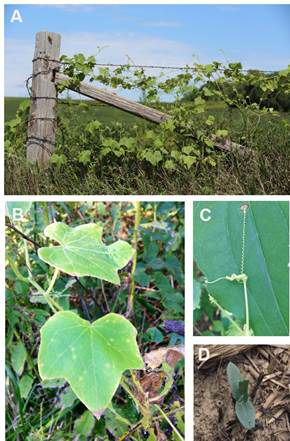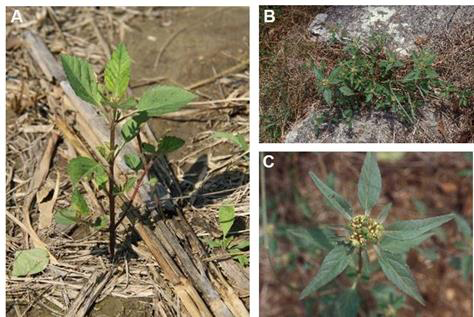Source: University of Missouri Extension
Burcucumber could reduce soybean yield as much as 48%, said University of Missouri Extension weed scientist Kevin Bradley at the recent MU Extension Crop Management Conference.
The summer annual weed resembles the cultivated cucumber. It has tendrils for climbing and sticky hairs. The climbing weed is difficult to control in soybean; it can germinate into the later months of the growing season after herbicide applications have been applied. It also appears most in low-lying areas and near creeks and rivers (Figure 1).
Bradley said its weighty vines also can lodge corn. Pre-emergence applications of atrazine or atrazine-containing pre-mixes will provide early-season control, but a post-emergence herbicide application usually is necessary.
Find a more thorough description of burcucumber and control recommendations at: http://ipm.missouri.edu/ipcm/2014/9/Burcucumber-An-Agronomic-Pest-on-the-Increase/.
The toothed spurge (Figure 2), another summer annual, is appearing in northwestern Missouri, Bradley said. It is often incorrectly referred to as a wild poinsettia, and is found in pastures and along roadsides. Recently toothed spurge has become more common in soybean fields.
 Figure 1: Burcucumber is a vining weed (A), which is becoming more common in Missouri. The leaves are hairy and have 3 to 5 pointed lobes (B). The vine uses tendrils to climb plants and fences for support (C). The cotyledons are thick and oblong (D). |
The plant can grow up to 2 feet tall and has light green to reddish green stems with short hairs. The leaves are elliptical or ovate, have toothed margins and are usually bunched near the upper portion of the plant. The leaves and stems emit a white milky sap when broken. The sap produces blisters and dermatitis in humans, cattle and horses, and causes blindness if it comes in contact with the eye.
Toothed spurge is tolerant to normal use rates of glyphosate, and little information is presently available on the control of toothed spurge in corn and soybean production systems. A pre-emergent application of atrazine and isoxaflutole seems to provide good control in corn, while flumioxazin works in soybeans.
Find more information on toothed spurge and post-herbicide control options at:http://ipm.missouri.edu/
The MU Extension’s WEED ID guide can be found on the website: http://weedid.missouri.edu/
It's also available as a free app, called ID Weeds, for Apple and Android mobile devices.

Figure 2: Toothed spurge is becoming more common in Missouri fields. (A) A toothed spurge plant emerges in a field. (B) Toothed spurge can be found in pastures and roadsides as well. (C) The leaves of toothed spurge resemble wild poinsettia.






Post a comment
Report Abusive Comment